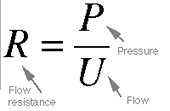Chapter 3: Fluid Flow in Respiratory Airways

Equation 3.1: Boyle's Law This is a simpler re-writing
of Equation 2.11, which is the ideal gas law with the right side
set
to a constant. It states that given a soft-walled enclosure with
a constant temperature, pressure and volume are inversely related;
increasing one causes a proportional decrease in the other. This
law explains why our lung pressure decreases when we increase the
lung volume by expanding the rib cage and contracting the
diaphragm.

Equation 3.2. Pulmonary power is the product of lung
pressure and flow. In speech and singing, the power being delivered
through the glottis by airflow can vary by a factor of at least 100
times! The approximate maximum power a human can deliver is one watt,
as given by the equation below:

Equation 3.3. This simply uses Equation 3.2 above and some
assumptions of human lung pressure and flow rates to arrive at the
1 watt estimate.

Equation 3.4: Continuity Law of Incompressible Flow. Assuming
that airflow is confined in a duct or pipe, and that density does
not change when the air travels through a constricted space (i.e.
the air cannot be compressed), this law dictates that the speed of
the air must increase as it travels through the constriction, in
order to make up for the smaller space.


Equations 3.5 and 3.6: Bernoulli's Law (Conservation of Energy). Since
the pressure and the particle velocity are on the same side of this
equation and are added to result in a constant, and since fluid density
does not change, we can see from this law that if the particle velocity
increases, like it would in a constriction, the pressure must decrease,
which seems counterintuitive, but is true anyway. That's life for
you.

Equation 3.7. R, resistance, is given as
the ratio of pressure to flow. This ratio is different for different
constrictions in the vocal
tract, such as the glottis itself, or the small space between your
tongue and teeth when you produce an [s] sound.

Equation 3.8. This equation defines Reynold's number,
which helps to characterize how flow will behave through various
constrictions. Fluid mechanics engineers have discovered that when
this number is larger than a critical value, flow tends to be turbulent,
i.e., it basically sprays all over the place chaotically after exiting
from the constricted space, like a garden hose with the end covered
mostly by your thumb. But if Reynold's number is smaller than the
critical amount, the flow is laminar, or smooth, like an open
garden hose.
Chapter
2 Equations Equations
Homepage Chapter
4 Equations
|



